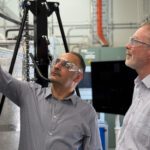Curtin University researchers have developed a particle detector at the remote site of the Murchison Widefield Array (MWA) radio telescope that is capable of conducting a ground-breaking study into mysterious cosmic rays in the area’s harsh conditions.
The project is the first coupling of a particle detector with the MWA, located in Western Australia’s Mid-West region about 800km north of Perth, and will allow the researchers to study some of the most powerful and violent forces in the universe.
Project leader Dr Clancy James, from the Curtin Institute of Radio Astronomy and the International Centre for Radio Astronomy Research, said the project would study the origins and properties of cosmic rays, which are particles with potentially more than 10 million times the energy produced by the world’s most powerful particle accelerator, the Large Hadron Collider.
“Cosmic rays constantly bombard Earth from space but we don’t know where they come from or what is accelerating the particles,” Dr James said.
“This project harnesses the power of the MWA to extend our knowledge of particle physics beyond what has been learned through the Hadron Collider.
“Unlike normal radio astronomy, with this project we aren’t looking at signals coming from billions of light years away but at cosmic rays as they hit the atmosphere about 100km above the ground. From there, we monitor the particles as they fragment and cascade down through the atmosphere.
“We expect a cosmic ray to occur over the MWA site about once an hour and to last only a microsecond at most. The particle detector needs to zero in on just the tiny fragment of radio data that we are interested in, which is an incredible feat.”
Dr James devised the experiment together with Dr Justin Bray from the University of Manchester. The project was deployed to the Shire of Murchison with help from members of the MWA operations team and used electronics developed by CSIRO in Sydney and ASTRON, the Netherlands Institute for Radio Astronomy.
“Dr Bray developed the particle detector using parts donated from a cosmic ray experiment at the Karlsruhe Institute of Technology in Germany,” Dr James said.
“The original detector emitted too many radio waves that would interfere with the MWA so we had to develop our own design of particle detector.”
The particle detector is housed in a metal box that protects its delicate and highly technical interior from heat, wind and light. It also prevents radio bursts emitted by the device from interfering with the MWA, which is one of the most sensitive radio telescopes in the world.
MWA Director Professor Melanie Johnston-Hollitt, from Curtin University, said the project extends MWA’s radio astronomy capability to timescales shorter than ever before seen with the instrument.
“This project enables a radio telescope to carry out particle physics that have never before been achieved in Australia,” Professor Johnston-Hollitt said.
“By pairing the MWA and particle detector in this study, we expect this to pave the way for much larger experiments with the Square Kilometre Array (SKA).”
The SKA is a global mega-science project to develop the world’s largest and most sensitive radio telescope, essentially a network of linked antennas, with a total signal collecting area of one square kilometre.



